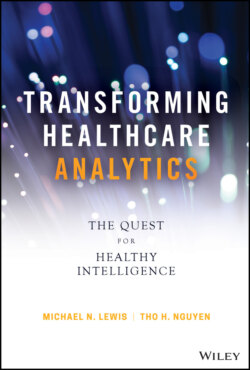Читать книгу Transforming Healthcare Analytics - Michael N. Lewis - Страница 9
ОглавлениеForeword
by James Taylor 1
I have been working with advanced analytics for nearly 20 years. The market has matured dramatically to the point where analytics, machine learning, and AI are now common topics of conversation in every industry. Once, analytic models were handcrafted for a few high-value scenarios. Now, companies are automating the creation of advanced analytics and using them to solve a wide range of problems. The time to develop and deploy advanced analytics has gone from months to seconds, even as the amount of data being analyzed has exploded. Every industry is focused on being more data-driven and healthcare is no exception.
Tho and I met many years ago through our work as faculty members of the International Institute for Analytics. We have a shared interest in the technologies and approaches of analytics and in how organizations can truly take advantage of their data.
Healthcare is an industry that impacts everyone throughout their life. New drugs, new treatments, and new understanding drives continual and rapid innovation. Yet even as healthcare technology and treatments get more effective, populations in many countries are struggling with older populations and an epidemic of obesity. Drug resistance is an increasing problem and costs continue to rise. The healthcare industry needs to find ways to use data to tackle these and many other challenges.
Healthcare organizations have a particular challenge when it comes to analytics. Healthcare data is uniquely complex and uniquely sensitive. It must capture the state of a complex, living person. It is only imperfectly digitized and much of it is image related, time series related, or both – hard classes of data to manage and analyze. It is also intensely personal, so its use is regulated and controlled to protect people's privacy and prevent health-related discrimination. Taking advantage of this data to reduce costs and improve outcomes is both essential and complex.
Over the years I have worked with hundreds of organizations that are using analytics to improve their decision-making. Like Tho and Mike, I have come to see that people and process are as essential as technology – perhaps even more so. Building cross-functional teams, engaging a broad set of skills, and having a process that focuses on decision-making are all necessary if analytic technology is to be applied effectively.
Take one healthcare provider I was working with recently. A technical team had developed some potentially useful analytic models. But working alone they could get no traction. We engaged clinical and operations staff in a discussion of the current decision-making. We applied design thinking and decision modeling to see how that decision might be improved with the analytic. With this shared understanding the technical team could see what a minimum viable product would require and could execute a series of Agile sprints to deliver it. People, process, and (analytic) technology.
With this book, Tho and Mike hope to show healthcare professionals how to transform their industry with data and analytics. Right from the start, they emphasize the importance of people, process, and technology – not just the coolest, newest technology. Real-world stories of healthcare problems addressed by insight-driven decisions show healthcare professionals what's possible and what technology exists. The stories help bring to life how analytics might create a more effective future state in healthcare.
The core chapters on People, Process, and Technology are full of great advice. There is a discussion of the skills needed, especially in analysis and business understanding. The need to invest in a wide range of roles (not just hire unicorns) and the importance of changes in sponsorship culture are emphasized. Three critical elements of process are discussed next. Design Thinking – something we find very effective in defining how analytics can improve decision-making – Lean and Agile. Our experience is that the hardest problem is defining the business problem so analytics can be applied effectively. As the authors point out, success therefore requires process change and the creation of a repeatable, sustainable playbook. The technology chapter gives a succinct but complete overview of available technology. All of this is pulled together into a framework for integrating people, process, and technology to drive culture change and move up the analytic maturity curve. The authors talk about the importance of focusing on data as an asset, bringing together cross-functional teams, providing clear leadership, and investing in growing analytic talent. All of this is illustrated with real-world case examples. A final chapter lays out what's coming and how will it change healthcare, especially the growth in sensors and devices connected through the Internet of Things, the growth of the cloud, and the adoption of artificial intelligence.
If you are a healthcare professional concerned about applying data and analytics to improve your organization, this book will give you valuable insights. The advice and framework will help you organize, recruit, train, and develop the data analytics capability you need.
Healthcare needs to become more data-driven, more analytic. This book will show you how.
NOTE
1 1 James is CEO and Principal Consultant, Decision Management Solutions and a faculty member of the International Institute for Analytics. He is the author of Digital Decisioning: Using Decision Management to Deliver Business Impact from Artificial Intelligence (MK Press, 2019) and Real-World Decision Modeling with DMN with Jan Purchase (MK Press, 2017). He also wrote Decision Management Systems: A Practical Guide to Using Business Rules and Predictive Analytics (IBM Press, 2012) and Smart (Enough) Systems (Prentice Hall, 2007) with Neil Raden. James is an active consultant, educator, speaker, and writer working with companies all over the world. He is based in Palo Alto, CA and can be reached at james@decisionmanagementsolutions.com.
